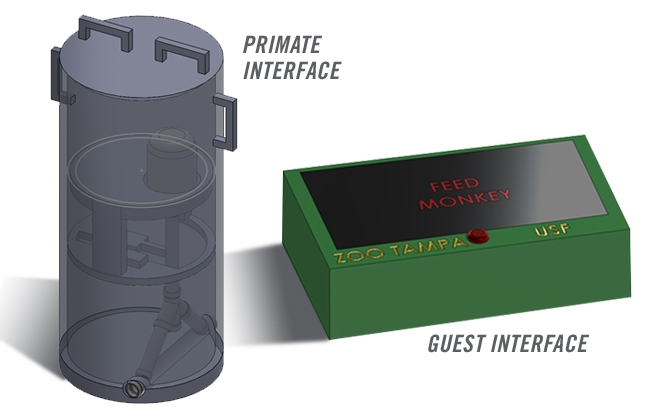College of Engineering News Room
Mechanical Engineering Student Capstone Project at ZooTampa
By Brad Stager
Senior capstone design courses at the University of South Florida’s College of Engineering go beyond applying learned knowledge and skills in the classroom. Students have opportunities to solve real-world problems on behalf of community partners such as corporations, schools, governments, and non-profit organizations. It is an opportunity to engineer solutions for the benefit of other people, or in one case, a community of small primates in Tampa.
Stephanie Carey is a research professor with the Department of Mechanical Engineering and is the research director of the Center for Assistive, Rehabilitation and Robotics Technologies. She teaches a capstone design course and says the projects are an important part of training new engineers.
“I try to get projects that are important to industry — real-life projects,” she said.
Carey, who received her PhD in biomedical engineering at USF, adds that students develop communication and customer service skills as well as technical ones.
One of the most popular attractions for visitors and locals in the Tampa Bay area is ZooTampa at Lowry Park, a 63-acre zoo in the heart of Tampa. Among the many live animal collections there, small primates such as lemurs attract a lot of attention from people who pause to observe the animals’ behavior. A capstone design project will create opportunities for visitors to interact with the animals through technology being developed by mechanical engineering students at USF.
The students are designing and building a device that will deliver food to the primate habitat area in a way that stimulates the mammals' foraging instincts and also allows for engagement with zoo guests who will operate what is known among animal behaviorists as an enrichment device.

Sue Pasquine is ZooTampa's curator of behavior and she says that the benefits provided by the guest interaction enabled by the students' project has importance beyond meeting the animals' nutritional needs. It also stimulates them mentally and physically for the benefit of their health and sense of well-being.
"It’s enriching their lives,” she said.
Pasquine adds that working with the USF students helps the zoo meet its obligation to provide a beneficial environment, something that is a challenge to budget for.
"We need some assistance in that area," she said. "This kind of enrichment is expensive."
One way to minimize overall cost is to ensure a level of durability that can stand up to intense scrutiny and rough handling by primates possessing considerable strength and intelligent curiosity. It’s a concern that became a priority for the students.
“It’s a lot different designing something a human can use and something for an animal that needs to be destruction proof,” said USF mechnical engineering student Tyler Shriver.
Jamie Schramm, also a mechnical engineering student at USF, is the team lead for the project and says the design parameters were clear, but there were no limits placed on finding a solution.
“It was open-ended, and we could really run with it,” Schramm said.
The final design of the animal enrichment device consists of two units. One is a primate subsystem consisting of a wire-suspended metal tube, 39 inches in length and a foot in diameter, that contains food, a release system and an Arduino IR receiver. A transmitting controller will be operated by zoo guests to scatter the food within the animal habitat at designated times.
Other students involved in the ZooTampa enrichment device project are Alexandra Collins, James Couture and Juan Rosa. The zoo’s Pasquine acknowledged the project team’s hard work.
“We appreciate all the knowledge the students have, and their skills, to create something like this,” she said.
Another project undertaken by Carey’s students is one focused on demonstrating the engineering design process to students enrolled at James Buchanan Middle School in Hillsborough County.
For the project, the mechanical engineering students are building a water-powered model car that will be the subject of a presentation at the middle school.

Whereas the students involved in the animal enrichment project tackled a specific problem for a client, the water-powered car is meant to drive home the possibilities that exist in engineering to a younger audience. This impact on students who are on the cusp of choosing careers has long-term consequences for society, as does the matter of renewable energy.
The USF students’ design project considers these two issues by applying a renewable source of energy to power a vehicle and presenting the design in an engaging way that generates interest in STEM careers among middle school students.
“I have a passion for the environment, so I think it’s important to educate younger people about environmental design,” said USF mechanical engineering student Gabrielle Annis.
Other mechanical engineering students involved in the water-powered car are Amber Copeland, Michelle Pavlik, Madison Peyton and Noah Spameni.
In the students’ design, an off-the-shelf remote control model car with a chassis of 14.5 inches in length is modified with a 3D-printed body that houses a hydrogen fuel cell subassembly. The subassembly includes polymer electrolyte membrane electrolyzer and water reservoirs to power a 12-turn electric motor.
Besides presenting the concept of an alternative source of energy, Spameni wants the Buchannan students to see how a STEM career is a viable alternative for anyone who is interested.
“It doesn’t take a genius to engineer something,” he said. “It takes time and research.”
The USF students plan to present their design project to Buchanan Middle School students in the spring.
Capstone design projects like these and others, such as ones that address personal mobility and rehabilitation for example, are an opportunity to demonstrate the influence that the College of Engineering can have beyond campus, said Carey.
“I’m really excited to get more projects out in the community to show people what USF students can do,” he said.